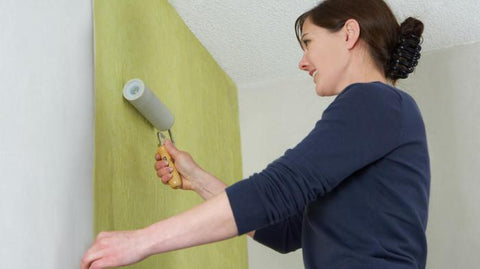Non-woven wallpaper
Before starting work and gluing wallpaper, we encourage you to focus on the following aspects - check the articular number, the batch number made, and the signs on rapports. Please keep the controls and wallpaper samples.
Carefully prepare the base
Substrate preparation - the substrate must be dry, durable, able to evenly absorb moisture, clean, neutral and smooth. Old wallpapers and water -soluble lacquered coverings must be removed. The cracks and holes must be scratched with a filler mixture if necessary, while surfaces characterized by high moisture absorption must be pre -cut with glue. Old, elusive surfaces that are unable to carry the load must be spelled with a specially designed primer under the wallpaper.
Caution! Non-Woven wallpapers It should be glued on a homogeneous color. For this reason, we recommend applying a pigmented background under the wallpaper.

The glue should be applied directly to the wall ...
We recommend using a good, reliable brand glue specially designed Non-woven Wallpaper, and follow the instructions included in the instructions for making the glue. Mix thoroughly Non-woven wallpaper glue following the manufacturer's instructions. Apply the glue on the wall width of the wallpaper with the roll.

Wallpaper is glued ...
Non-woven Wallpaper gluing is always started "out of light", which means that the wall sticking should start at the window. Pay attention to the first sheet of wallpaper glued in a vertical line, well leveled vertically - so that the next sheets can be glued straight.
After the wall is covered with glue, Non-woven Wallpaper glue directly on the wall and smoothed with a roller; In addition, this type of wallpaper does not require time to impregnate the glue. With gentle brushes or rags used for wallpaper gluing, or the microporacic rubber roller press the sheet tightly on the wall and level it to avoid the formation of bubbles.

Cut the leftovers and ready ...
The hanging walls are cut from the top and bottom. The next wallpaper sheets are glued in a precise collision or joint. You can use a conical roller for suture treatment instead of the joint joint. Pay attention to the fact that heavy heat and drafts should be avoided during wallpaper processing and drying. The optimum operating temperature ranges from 18 ° C to 25 ° C.
Additional tips
Another advantage of wall decoration with Non-woven For wallpapers - if the wallpaper treatment is properly processed, the wallpaper will be easily removed from the wall dry in the next repair.












